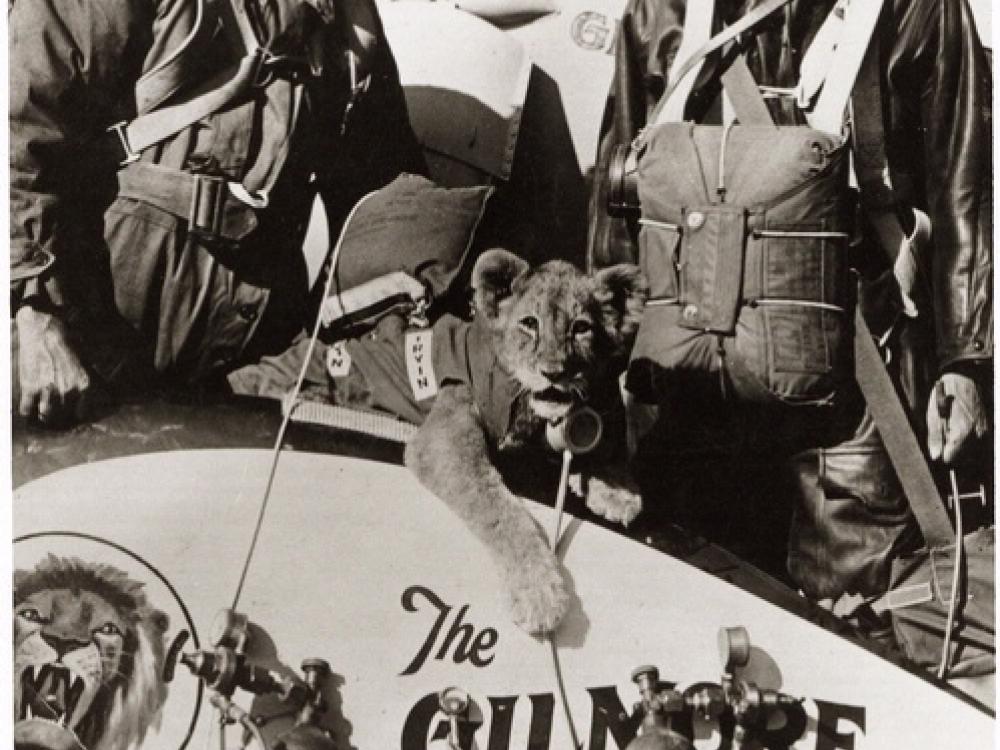
Roscoe Turner and Gilmore the Flying Lion
Jul 18, 2022
By Jeremy Kinney

Jul 18, 2022
By Jeremy Kinney
There’s no excuse for an airplane, unless it will fly fast!
It’s a bird, it’s a plane, it’s a...lion? Roscoe Turner was the most famous air racer of the 1930s. While his winning record and larger-than-life persona was enough to cement him in aviation history, Turner’s air racing career included flying with a peculiar co-pilot who was a little furrier than average: a lion cub.
Flamboyant and charismatic, Roscoe Turner’s fame as a “speed king” transcended aviation into popular culture in the 1930s. During his racing career, he won the illustrious Thompson Trophy race in 1934, 1938, and 1939.
Sponsored by Thompson Products of Cleveland, the Thompson Trophy race was part of the National Air Races. The race was a closed-circuit, pylon-marked contest in which pilots in their purpose-built racers flew at high speed and low altitude, all in view of the spectator grandstands.
Roscoe also won the Bendix in 1933—a transcontinental air race that began in 1931 to encourage the development of practical, high-speed, long-range aircraft. Like the Thompson trophy, the Bendix trophy had a corporate sponsor: the Bendix Corporation. The race inaugurated the week-long activities of the National Air Races and typically flew between Burbank, California and Cleveland, Ohio.
Ever the showman, Turner designed his own flying uniform and personal insignia to increase the appeal and image of aviation. Enthusiastic children could send in special “57” trademarks from H.J. Heinz Company products to join Turner’s club—Col. Roscoe Turner’s Famous Flying Corps. In return, they would receive a brass pin featuring wings embossed with “Col. Roscoe Turner’s Flying Corps 57.”
So where does the lion come in? In early 1930, Turner received a major sponsorship from the Gilmore Oil Company, which was well known for its Red Lion gasoline brand. In true Turner fashion—he sought a colorful way to promote the company’s products—and the concept of Gilmore the Flying Lion was born. Turner purchased the male lion cub, who was born on February 7, 1930, from the Louis Goebel Lion Farm in Agoura, California.
Turner and Gilmore began flying together in April 1930, mostly in the pilot’s Lockheed Air Express. In response to complaints from animal rights groups, Turner had a static line parachute and harness made for the cub. Gilmore and Turner broke speed records flying from Los Angeles to New York and from Vancouver in Canada to Agua Caliente, Baja California, in Mexico. On the ground, Gilmore became something of an ambassador for aviation, accompanying Turner to public air shows, movie premiers, restaurants, hotels, and even golf courses.
However, there is a logistical problem (among many others) with having a lion for a co-pilot: at a certain point they are going to get big. Really big. Gilmore and Turner flew together for only nine months before the courageous cub grew too big. Despite his short career, Gilmore logged over 25,000 miles (40,000 kilometers) in the air.
Unfortunately, after Gilmore retired as Turner’s co-pilot, he spent the remainder of the decade in a small cage displayed first at the Burbank, California airport and later at a Gilmore gasoline station in Beverly Hills. Gilmore also continued to make periodic publicity appearances with Turner, but this time only from the ground.
In 1940, Gilmore returned to Goebel’s farm and lived there until he died in December 1950. Turner had the lion’s remains sent to a taxidermist and then brought to his home in Indianapolis. From there, Gilmore spent a brief stint at the Turner Museum after Roscoe Turner’s death and before the museum closed in 1972. He now resides in the National Air and Space Museum’s collection, along with other Roscoe Turner memorabilia.
Read about the conservation of Gilmore the Flying Lion, detailing discoveries made during our initial examination into this unique object’s construction, previous repairs, and his current condition:

We rely on the generous support of donors, sponsors, members, and other benefactors to share the history and impact of aviation and spaceflight, educate the public, and inspire future generations. With your help, we can continue to preserve and safeguard the world’s most comprehensive collection of artifacts representing the great achievements of flight and space exploration.
We rely on the generous support of donors, sponsors, members, and other benefactors to share the history and impact of aviation and spaceflight, educate the public, and inspire future generations. With your help, we can continue to preserve and safeguard the world’s most comprehensive collection of artifacts representing the great achievements of flight and space exploration.